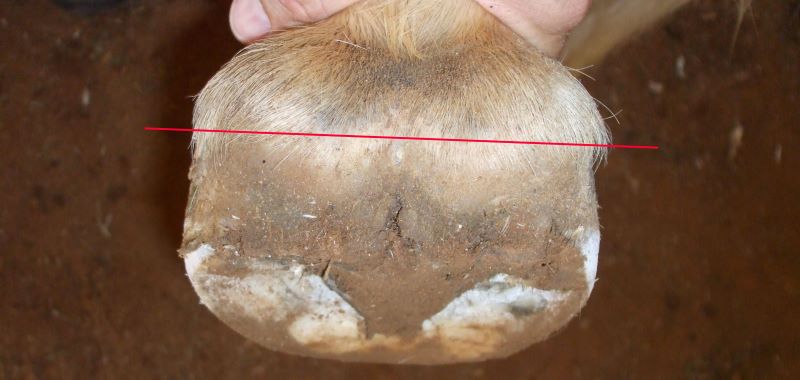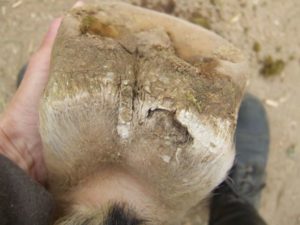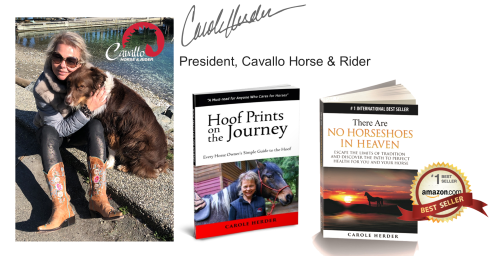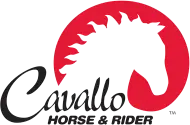Say Hello to Healthy Heel Bulbs!

– By Carole Herder
Heel Bulb Injuries Can Run Deep
 Does your horse have healthy heel bulbs? Heel-bulb wounds and injuries are common among horses. Kicks, entanglement with wire fencing, rope abrasions, and protruding objects in a stall are but a few of the causes. Self-inflicted wounds caused by interference or over-reaching can also cause issues. Any lacerations or cuts should be treated seriously, as they may be life-threatening. The external severity of the lameness is not a reliable determination of the involvement of underlying deeper structures. Depending on the structures involved and the degree of damage incurred, other areas could also be involved. Possible damage to the navicular bursa, deep and superficial digital flexor tendons and sheaths, distal digital and sesamoidean ligaments, digital veins, arteries, nerves, and connective tissues should also be assessed.
Does your horse have healthy heel bulbs? Heel-bulb wounds and injuries are common among horses. Kicks, entanglement with wire fencing, rope abrasions, and protruding objects in a stall are but a few of the causes. Self-inflicted wounds caused by interference or over-reaching can also cause issues. Any lacerations or cuts should be treated seriously, as they may be life-threatening. The external severity of the lameness is not a reliable determination of the involvement of underlying deeper structures. Depending on the structures involved and the degree of damage incurred, other areas could also be involved. Possible damage to the navicular bursa, deep and superficial digital flexor tendons and sheaths, distal digital and sesamoidean ligaments, digital veins, arteries, nerves, and connective tissues should also be assessed.
Additionally, bulb injuries are often complicated by infection. Due to the inherent movement of the area, the wound experiences delayed closure and can attract debris. Even after closing, granulation tissue may cause it to re-open.
A Peek Inside the Bulbs
Heel bulbs are soft horn tissue with a cushion of connective tissue on the interior side, providing the bulbs with springiness and flexibility. The bulb’s corium produces a delicate pliable horn. This horn contains a large amount of water and sweat glands. It is a fragile area, which can become damaged from consistent or intermittent pressures on or above the bulb or coronet band area. Stress can be caused by the hard plastic of certain hoof boots, bell boots or other equipment. Damage is usually accompanied by a reduction of the nutritional properties of blood circulation. It is essential to understand the delicate nature of this area and keep it protected from harm.
Underrun Heels – A Hoof Health Epidemic
In a properly functioning hoof, the frog’s collateral grooves extend past the heels outside the curves of the bulbs. If the grooves are within the curves, there is a contraction, often accompanied by underrun heels. With this condition, the heel distorts inward and under the hoof, rather than slanting outward towards the back. Contrast this to a healthy hoof, where the heel is on an angle away from the toe. This angle constructs a larger, weight-bearing platform, better accommodating the horse’s weight.
Unfortunately, underrun heels are a common disorder. And any heel pain forces the horse to change his way of moving by creating an unnatural toe-first landing. The appearance of a contracted, underrun hoof is so typical that it can be considered the norm. The hoof looks long and narrow, particularly towards the back half. The heels look like they pinch together, squeezing the bulbs and frog. The heels curve in like hooks towards the frog, creating a V-shape instead of a straight line. The collateral grooves on either side of the frog are not in a clear line and fall within the heel curve. Inflamed and excessive soft bulb tissue protrudes out from the heel area. These should be protected until you arrange to resolve the condition.
Babying those Blubs
To achieve healthy heel bulbs, one must work toward re-establishing proper hoof form, correct function, and good quality blood circulation. Movement, hydration, appropriate trimming, hoof protection, adequate nutrition and inclusion in a herd environment can provide your horse with both the physical and emotional elements to expedite healing. Soft padding will provide comfort and protection while working to improve the situation. Some hoof boots provide appropriate padding to this delicate area.
*******
Sign up here for Cavallo’s free newsletter and special community discounts: https://www.cavallo-inc.com/CavalloNews

